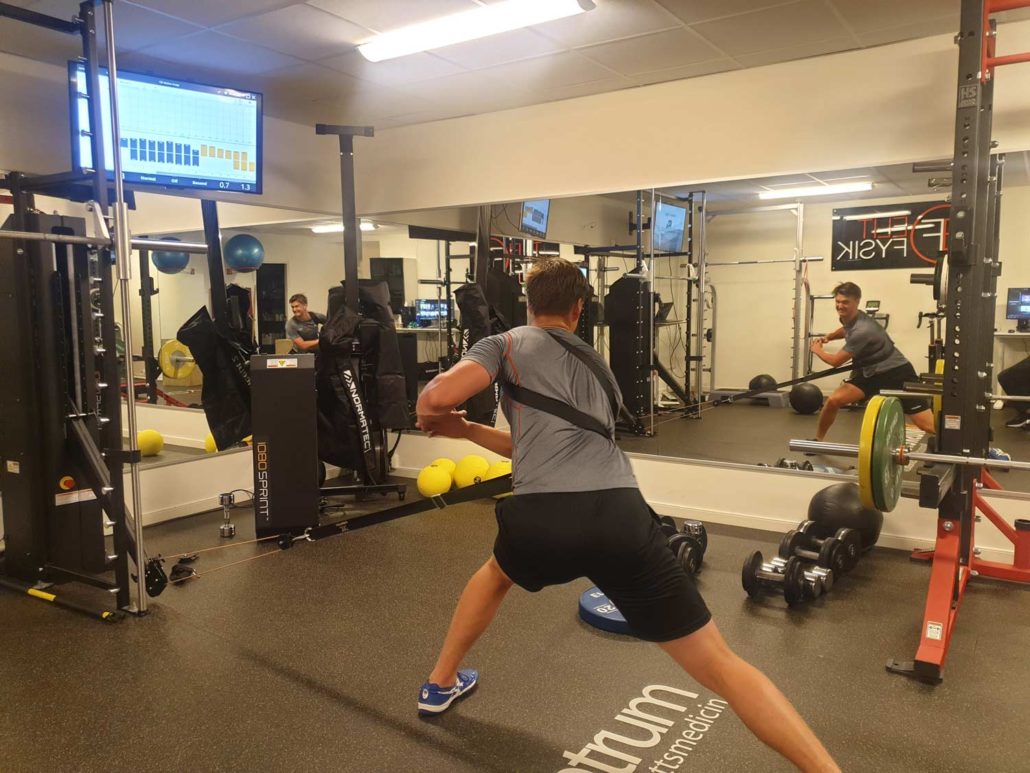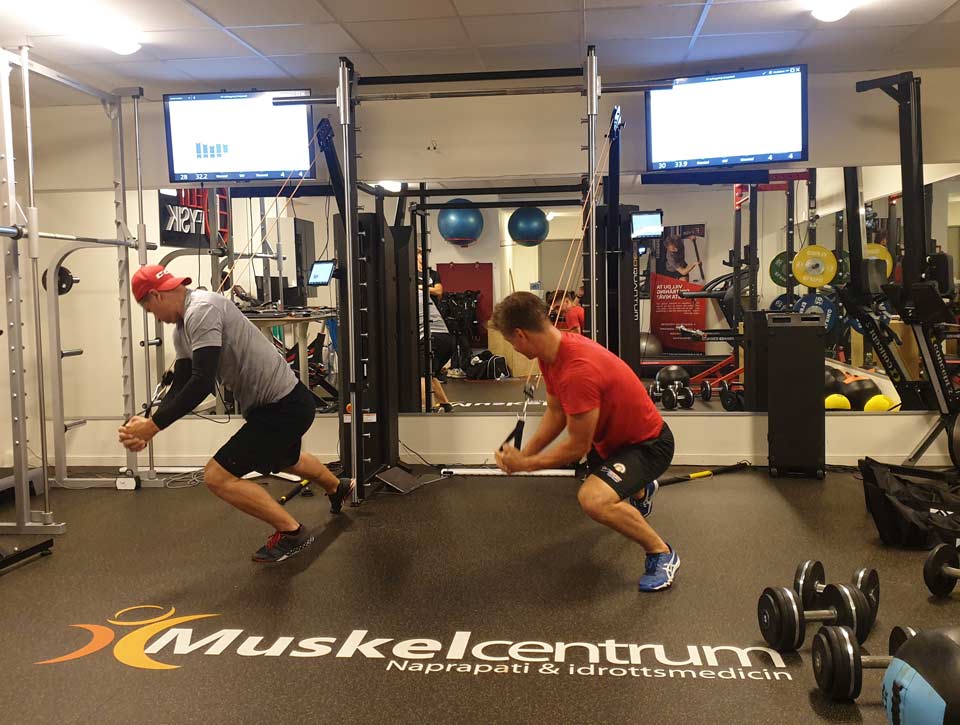Outside of trampoline gymnastics, there are few land-based sports where the surface for performance and the surface for performance training differ quite as profoundly as ice hockey. Strength and conditioning coaches working in the sport must address a number of issues that are bandied about in the gap between slick ice and solid ground: specificity, transfer, instability, biomechanics, you name it.
Working with top hockey prospects, Johan Söderström—himself a former elite hockey player and currently a performance coach, naprapath, and clinic head at Muskelcentrum (Uppsala, Sweden)—looks at the needs of his athletes and the window of their off-season training and opts for a model driven by specificity.
[av_button_big label=’More ice hockey:’ description_pos=’below’ link=’manually, https://1080motion.com/olympic-hockey-training-cory-kennedy/’ link_target=” icon_select=’no’ icon=’ue800′ font=’entypo-fontello’ custom_font=’#ffffff’ color=’theme-color’ custom_bg=’#444444′ color_hover=’theme-color-subtle’ custom_bg_hover=’#444444′ av_uid=’av-154cfr9′]Speed On The Ice: Olympic Training With Cory Kennedy[/av_button_big]
“If you train younger people, it is better to do it more generally,” Söderström says. “But for me, I have a couple of high performance hockey players that play in the NHL, AHL, or KHL. They already have that (general athleticism), so for me, to give them a lot of improvement in a three month program, I need to be really specific.”
With a training group that includes, among others, Gustav Lindström (Detroit Red Wings 2017 NHL 2nd Round pick), Magnus Hellberg (1st goaltender selected in the 2011 NHL draft, currently in KHL) and Simon Lundmark (Winnipeg Jets 2019 NHL 2nd Round pick), Söderström begins with a testing battery that includes analysis from photo cells, VO2 Max readings, and data collected from 1080 Quantum Syncro and 1080 Sprint. From that data-based foundation, Söderström develops a periodization plan in which he tries to make the programming as sport-specific and individualized as possible.

“For me, when I played, we never had a trainer who said any kind of purpose for what we were doing. It was only do five reps and five sets in the squat. And then on to the lunge, and so on, over and over again,” Söderström says. “So for me, it’s really important with the players I train, they need to know why and what I’m looking for.”
1. Acceleration
The high speed and power output of the better skaters is a result of a high amount of work per stroke, caused by a short and effective directed push-off. These results strongly support the previous finding that skaters of different performance levels can be distinguished by differences in amount of work per stroke and not by differences in stroke frequency. — Ruud W. de Boer, Gertjan J.C. Ettema, Hans van Gorkum, Gert de Groot, and Gerrit Jan van lngen Schenau
In his baseline testing, Söderström looks at speed metrics, each athlete’s power equation, and their acceleration ability before creating his training plan. While not working specifically on the ice, Söderström trains the specific qualities that translate to effectiveness in the rink.
“We have a couple of studies saying that you have a good correlation between the first three steps in sprinting and the first three strides in ice hockey,” Söderström says. “When I use the 1080, the main goal for me is they need to accelerate, they need to put a lot of power into the floor.”
Söderström then programs jump sequences and resisted exercises with the 1080 specifically designed to enhance power and speed in those first three strides, making sure to explain the why to his athletes: that performing those resisted movements with 100% intent will transfer to the ice. While being a fast skater does not make one a world class sprinter any more than being a top sprinter means you will be able to skate a breakaway, within individuals, improvements in acceleration on land can lead to greater speed on the ice. Strength Coach Cory Kennedy, working with hockey players on the Canadian Women’s National Team, passed along the same opinion on speed and transfer in a previous discussion with us on the 1080 Blog.
“One of the things I’ve noticed anecdotally is that as we worked speed, players felt faster on the ice,” Kennedy said. “The transfer idea seems to click, so I decided to do my own research to confirm this. With the preliminary results, I’m pretty confident that there’s a really close path between how fast you run and how fast you skate.”
2. Change of Direction
“Change of direction you use all the time in ice hockey,” Söderström says. “For every stop you do, it’s a lot of resistance because you need to go up in speed before you can use the ice as an easy way to move or get the skates to glide.”
Söderström programs common change of direction exercises, utilizing 5-10-5 and 10-5-10 shuttle runs, but with a twist: adding measured assistance or resistance from the 1080 Sprint in order to specifically mimic either the momentum gained in a glide or the force needed to change course on the ice.
“In the five-ten-five, for example, the first five meters they will have assisted sprinting, so they will be able to have higher speed when they come to the next change of direction,” Söderström says. “So, basically they need to learn how to put even more power into the floor to change the direction as fast as possible to go again with resisted sprinting.”
In addition to assisting portions of change of direction work to match gliding speeds on the ice, Söderström programs resistance to further develop that need to put even more power into the ground.
“I also try to do exercises where they move with a high load for three meters, then they need to explode back with only one step, and then go again,” Söderström says. “So we focus on the turning with a maximum resisted sprint.”
3. Rotational Power
Primarily, ELITE shooters are thought to better utilise the loading phase of the slap shot, causing increased shaft deflection, a longer period of stick–ground contact and higher vertical ground reaction forces which combine to generate higher stick elastic (or bend) energy, thus imparting a greater impulse on the puck (Pearsall et al., 1999; Roy & Doré, 1976; Villaseñor-Herrera, 2004).
“If you look at ice hockey, many people think the sport is sagittal, but it’s mainly rotational and lateral plane if you look three-dimensionally,” Söderström says. “For me, if you look at a slap shot, you have a lot of rotational power in it, and with every stride and every turn you need to be really strong in rotation because you start every movement with a rotation.”
Targeting rotational power with his hockey athletes, Söderström integrates specific movements to increase speed and power in the loading phase of the swing, while also considering the challenges of producing a powerful slap shot while on skates.
“For ice hockey, I frequently use different kinds of wood chops, both with two legs and one leg,” Söderström says. “Because with ice hockey you have only one base of support on an ice skate and need to be really strong even with one foot in the floor.”
4. Hypertrophy and Power-Strength Training
Acceleration, change of direction, rotational power—each relies on the rapid creation of force, and Söderström separates hypertrophy and power-strength in order to develop the strength qualities specific to hockey movements.
“In hypertrophy, I use the speed limits a lot,” Söderström says, discussing the settings on the 1080 Syncro. “Because if you want a successful hypertrophy phase, you need to think a lot about time under tension—if it’s too high it will be endurance, and if it’s too low it will be more like for maximum strength… but since it’s not that high of a load, you probably won’t get maximum strength either. So I use it to monitor players who will be under a certain amount of time under tension for every rep.”
Not all of Söderström’s training is specific, of course—he looks at the whole athlete and programs general, non-functional movements like squats and static lunges, and uses eccentric overloading at times when the athletes will have an adequate amount of time to recover from that stress on their muscles and central nervous system. He produces training results with a combination of stimuli, and separates hypertrophy and power-strength phases in order to produce better outcomes within each quality.
[av_button_big label=’Next post:’ description_pos=’below’ link=’manually, https://1080motion.com/florida-gators-track-new-tools-1080/’ link_target=” icon_select=’no’ icon=’ue800′ font=’entypo-fontello’ custom_font=’#ffffff’ color=’theme-color’ custom_bg=’#444444′ color_hover=’theme-color-subtle’ custom_bg_hover=’#444444′ av_uid=’av-pu1hkj’]If It Ain’t Broke: How Florida Track & Field Integrates New Tools In a Winning Program[/av_button_big]
“For me hypertrophy is one thing, and power-strength is something else,” Söderström says. “For power-strength I don’t use the speed limits, because if you look at power, you need to be fast and you need to be strong. So, then I look a lot at their watts… because maybe they can produce a really good wattage in 100 kilos, but I need to see if it can be even better on 110 kilos. Or 120? Or 90? Or 80? So I can be even more specific when I work out the players, because I need to hit that sweet spot, I need to hit the highest watt they can produce every time.”
Is It Working? Test and Re-Test
“I use the 1080 Quantum Syncro to test mostly what kind of force they can produce,” Söderström says. “I use it to correlate with the periodization I do, because if they have a lot of force, but they have lesser power, they need to be more explosive. So then I put most of my periodization in explosive and maximum power.”
Because he is targeting specific training goals, Söderström needs objective measures to assess if he is producing the desired outcomes—and, if not, evaluate the why and tackle the issue with solutions.
“Every player I train, we start with tests and then we get a good baseline,” Söderström explains. “From that baseline, I can always go back to the data from every workout and we can see okay, now we have improved, this is really good, now we just need to keep on going. Which is really important for me, because if I don’t see the improvements, then something is wrong. So I need to change my periodization, maybe change my program design, maybe talk about nutrition, how they sleep, how they eat, their wellbeing… I know the process will work, and if it’s not working, then something is wrong.”






























































